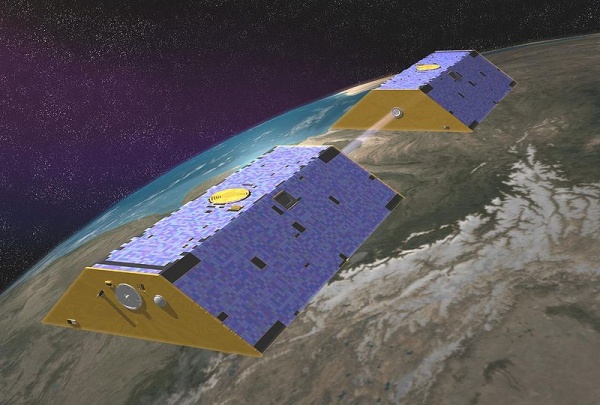Here’s some old news to some of you… but new to me.
Launched in 2002, the twin Gravity Recovery and Climate Experiment (GRACE) satellites have collected data for 12 years and are already in a decaying orbit that will suck them down to Earth in the next year or two. During their run they’ve carefully measured Earth’s gravitational pull and contributed to our knowledge of aquifers, ice sheets, magma and earthquakes — all because of gravity.
Did you know that gravity is uneven around the world and can vary in the same location during the year? Interestingly, water has a lot to do with it. Gravity is determined by mass so an increase in groundwater causes a higher gravitational pull. Since the GRACE satellites measure gravity, they find groundwater. It’s as if they were dowsing (finding water using a forked stick) from outer space.
Here’s how it works. Skimming like hockey pucks in their pole-to-pole orbit, the GRACE satellites maintain a 140-mile distance between each other which they measure constantly. Their microwave ranging system is so accurate it can record a 10 micrometre change in separation (1/10 the width of a human hair)! When the lead satellite first encounters a stronger gravitational pull, gravity makes it speed ahead, increasing the distance between them. When the second satellite encounters the same “bump” it speeds up too and their separation decreases. When they’ve both passed the “bump” they both slow down.
Round and round since 2002 they measure the distance between themselves and report back to Earth. NASA’s computers crunch the ebb and flow of gravity and create gravitational anomaly maps. Click here to see a selection of them.
The maps help scientists understand changes in aquifers and improve groundwater management. You can see the greatest anomalies in the tropics where there are dramatic wet and dry seasons. On this map(*) the Amazon basin is routinely blue (decreasing gravitational pull) in October at the end of the dry season and routinely red (higher gravity) in April at the end of the rainy season. Bangladesh’s color cycle is the opposite because its wet-dry cycle occurs during the other half of the year.
Until gravity pulls them down and ends their mission the GRACE satellites travel above us, dowsing from outer space.
(image of the GRACE satellites and photo of George Casely dowsing on his farm from Wikimedia Commons. Click on the images to see the originals)
p.s. Click here for more news from the GRACE satellites.
(*) Note that on this particular animated map the colors are “backwards:” red=wet, blue=dry


Saw a show on (I think) the Weather Channel about this, and they were discussing the gravitational anomalies around Hudson Bay. It was really fascinating.